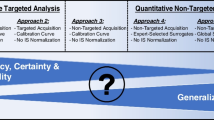The review justifies the need to validate the linearity, relative accuracy, and precision of Related Substances methods for detecting unidentified substances. Various approaches and methods for the estimation of linearity, precision, relative accuracy, and other validation characteristics for unidentified impurities are considered. The conditions necessary for the correct application of these approaches are discussed. The term “main unidentified impurities” is proposed and justified for assessing the validation results. Acceptance criteria, examples, and recommendations are provided.

Similar content being viewed by others
Notes
Acceptance criteria are numerical limits, ranges, or other criteria used to accept test results.
Information on the required columns for USP procedures: http://www.usp.org/resources/chromatographic-columns; for European compendial procedures, in Knowledge Database: https:/extranet.edqm.eu/publications/recherches sw.shtml.
References
International Conference on Harmonization (ICH) Harmonised Tripartite Guideline, ICH Q2(R1), Validation of Analytical Procedures: Text and Methodology, Geneva (2005); https: // database.ich.org/sites/default/files/Q2R1Guideline.pdf.
The United States Pharmacopoeia Validation of compendial procedures, USP41-NF36 (2018).
State Pharmacopoeia of the Russian Federation, XIVth Ed., Vol. 1, Moscow (2018), pp. 276 – 288; http: // femb.ru/femb/pharmacopea.php.
Technical Guide for the Elaboration of Monographs, 7th Ed., EDQM, European Pharmacopoeia (2015); https: //www.edqm.eu/sites/default/files/technicalguide for the elaboration of monographs 7th edition 2015.pdf.
Y. C. Lee, “Method validation for HPLC analysis of related substances in pharmaceutical drug products,” in: Analytical Method Validation and Instrument Performance Verification, John Wiley & Sons (2004), pp. 27 – 49; https: // https://doi.org/10.1002/0471463728.ch3.
I. Taverniers, M. De Loose, and E. Van Bockstaele, Trends Anal. Chem., 23(8), 535 – 552 (2004); doi: https://doi.org/10.1016/j.trac.2004.04.001.
D. M. Bliesner, Validating Chromatographic Methods. A Practical Guide, Wiley & Sons Ltd., Hoboken, New Jersey (2006), pp. 116 – 138.
V. V. Beregovykh (ed.), Validation of Analytical Methods for Drug Manufacturers. Typical Facility Guideline for Drug Manufacturing [in Russian], Literra, Moscow (2008); Validierung analytischer Verfahren der fiktiven Firma “Muster” fur die Arznemittel-Herstellung (der Bundesverband der Arzneimittel-Hersteller), BAH (2004).
M. E. Swartz and I. S. Krull, Handbook of Analytical Validation, CRC Press, Boca Raton-London-New York (2012), pp. 121 – 164.
Method Validation in Pharmaceutical Analysis. A Guide to Best Practice, 2nd Ed., J. Ermer and P. W. Nethercote (eds.), Wiley-VCH Verlag GmbH & Co,Weinheim (Germany) (2014).
A. I. Grizodub, Standardized Validation Procedures for Drug Quality Control Methods. State Facility “Ukraine Scientific Pharmacopoeial Center for Drug Quality” [in Russian], Kharkov (2016), pp. 69 – 97; http: // sphu.org/wp-content/uploads/2017/01/content-Gryzodub-book.pdf.
S. W. Baertschi, K. M. Alsante, and R. A. Reed (eds.), Pharmaceutical Stress Testing: Predicting Drug Degradation, 2nd Ed., Informa Healthcare (2011).
N. A. Epshtein, Razrab. Regist. Lek. Sredstv, No. 3, 118 – 132 (2016); https: // www.pharmjournal.ru/jour/article/view/298/294.
N. A. Epshtein, Razrab. Regist. Lek. Sredstv, 8(2), 122 – 130 (2019); https: // www.pharmjournal.ru/jour/article/view/692/673; N. A. Epshtein, Drug Dev. Regist., 8(2), 122 – 130 (2019); https: // www.researchgate.net/publication/ 334971858_VALIDATIONNo._ OF_ANALYTICAL_PROCEDURES_GRAPHIC_ AND_CALCULATED_CRITERIA_FOR_ASSESSMENT_OF_METHODS LINEARITY_Ino.PRACTICE.
N. A. Epshtein, Khim.-farm. Zh., 52(7), 50 – 60 (2018); doi: https://doi.org/10.30906/0023-1134-2018-52-7-50-60.
EAEU, Guideline for Validation of Analytical Methods for Conducting Drug Trials, Approved by Decision of the College of the Eurasian Economic Commission of Jul. 17, 2018, No. 113; https: // docs.eaeunion.org/docs/ru-ru/01418296/clcd_20072018_113.
K. Doerffel, Statistik in der analytischen Chemie, Deutscher Verlag fur Grundstoffindustrie, Leipzig (1990) [Russian translation, Mir, Moscow (1994), p. 177].
N. A. Epshtein, Khim.-farm. Zh., 53, No. 5, 55 – 60 (2019); doi: https://doi.org/10.30906/0023-1134-2019-53-5-55-60.
IncreaseWaters 996 Photodiode Array Detector Sensitivity with Maxplot, Waters (2009); http: // www.waters.com/webassets/cms/library/docs/wpp06.pdf.
N. A. Epshtein, Razrab. Regist. Lek. Sredstv, 8(1), 108 – 112 (2019); https: //www.pharmjournal.ru/jour/article/view/656.
N. A. Epshtein, Khim.-farm. Zh., 53(12), 48 – 57 (2019); doi: https://doi.org/10.30906/0023-1134-2019-53-12-48-57.
European Pharmacopoeia, 9.5th Ed., Chap. 2.2.46, Chromatographic Separation Techniques, EDQM, Strasbourg (2018).
N. A. Epshtein, Razrab. Regist. Lek. Sredstv, 14(1), 106 – 117 (2016); https: //www.pharmjournal.ru/jour/article/view/229/226.
N. A. Epshtein, Khim.-farm. Zh., 38(4), 40 – 56 (2004); http: //chem.folium.ru/index.php/chem/article/view/2339/1826.
T. Fornstedt, P. Forssen, and D. Westerlund, Trends Anal. Chem., 81, 42 – 50 (2016); doi: https://doi.org/10.1016/j.trac.2016.01.008.
N. A. Epshtein, Vedomosti HTsESMP, 7, No. 2, 85 – 91 (2017); https: //www.vedomostincesmp.ru/jour/article/view/124/123.
Author information
Authors and Affiliations
Corresponding author
Additional information
Translated from Khimiko-Farmatsevticheskii Zhurnal, Vol. 54, No. 9, pp. 48 – 56, September, 2020.
Rights and permissions
About this article
Cite this article
Epshtein, N.A., Sevast’yanova, V.L. & Koroleva, A.I. Validation of Related-Substances Determination Methods for Detecting Unidentified Substances (A Review). Pharm Chem J 54, 959–967 (2020). https://doi.org/10.1007/s11094-020-02303-x
Received:
Published:
Issue Date:
DOI: https://doi.org/10.1007/s11094-020-02303-x




